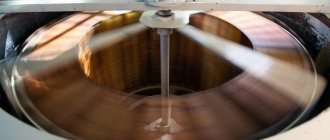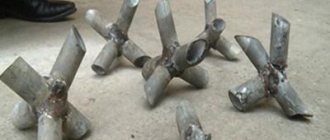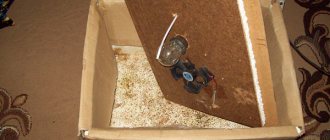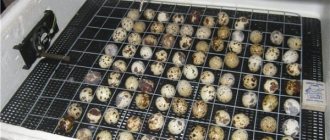When maintaining an apiary, beekeepers need to pump out honey, which is done using a honey extractor.
There are several ways to make a honey extractor with your own hands from available materials. This will help you save significantly on the purchase of expensive equipment. If you have only one hive in your apiary, you can get honey without a honey extractor by consuming it directly from the frame by breaking off the honeycombs. When keeping several bee colonies, a honey extractor is required to ensure high-quality pumping of honey.
This device is a kind of centrifuge equipped with a rotating drum and a stationary tank. Inside the structure there are special cassettes that rotate around their axis, into which frames are placed. As the drum handle rotates, honey begins to flow out of the honeycomb. At the same time, the frames remain intact, so they can be reused.
What is a honey extractor
A honey extractor is the most important item of a beekeeper’s household equipment. If it is very primitive, then it is an empty cylindrical tank, with an internal system of rotating frames on a rigid axis. At the very beginning of its creation, it was exclusively wooden. It was made from wooden barrels or tubs, and the entire working moving mechanism was also wooden.
Design and principle of operation
The fundamental operating principle of the honey extractor, created by F. Grushka, was so successful that it has remained virtually unchanged since its creation. Modern devices operate on the same principles of pumping out honey, but have a more advanced technological mechanism.
Description of the device using the example of a radial design.
The device is a metal tank with a curved cone-shaped bottom. Inside it there is a metal cage on a vertical axis. The vertical axis rests on a crosspiece, on which a “glass” is fixed, which has a steel ball at its base. The ball rests on a rod with a bore in the form of a sphere. The rod has a screw connection with a vertical axis, which is a 25 mm water pipe. At the top of the tank cone there is a metal tube 30 mm high. It prevents honey from flowing along the axis to the bottom of the honey extractor tank.
The steel cage of the device has upper and lower crosspieces. The lower cross supports a thrust circle and two circles with slots (loops) for frames. The upper cross supports a stop circle on top to secure the upper edges of the frames. The metal cage is located so that the lower part of the rotating frames does not touch the pumped out honey.
The upper part of the steel rod rotates in a ball bearing and has a bevel gear at the end. The ball bearing is mounted in the plane of the plate, which is attached to the cross member. The crossbar has a rigid fastening on both sides of the metal tank. The movement of the honey extractor cage occurs through a vertical gear on the upper crossbar, by rotating it manually (an axis with a handle) or electrically, using a belt or chain drive.
Important! When transmitting motion, the ratio of gears (transmitting to receiving) must be 1:3 to generate rotation up to 250 rpm.
To release the pumped out honey, the tank has a special sleeve, which is located at the bottom of the structure at the very bottom. The sleeve is equipped with a secant valve and works to “open” and “close” the container with honey.
The upper part of the honey extractor tank has semicircular covers that are attached to a plate with a ball bearing. The covers are equipped with edges; they tightly and securely cover the body of the device. For greater strength, the tank lid and the body itself have peripheral ridges. To prevent the semicircular covers from sliding off the tank during operation, they are attached to the gear with a special bracket.
The upper cross member with a rotating mechanism is secured to the tank hoop with special curved bolts. The bolts hold the outer vertical strips, which are rigidly attached to the lower hoop of the tank. This design firmly connects the upper and lower edges of the tank, preventing the structure from becoming loose during vibration.
The tank is installed on a cross (low table). The optimal lifting height of the body is 400-500 mm. For the convenience of receiving honey, the height of the legs of the cross is adjusted to the height of the container of the honey receiver (plastic or metal bucket, can, flask).
The operating principle of the device is based on the centrifuge mechanism. The main operating point in it is the centrifugal force, which causes the viscous consistency of honey to leave the honeycomb, melt and come out.
It goes like this. The frame with the honeycomb is printed with a special beekeeping knife and then installed in the cassette. Under the influence of rotation, a centrifugal force appears in the frame, which pushes the honey out of the honeycomb with great pressure. The liberated honey, under its own gravity, flows down the walls of the tank to the bottom of the honey extractor and by gravity flows out of the sleeve into the container.
Device manufacturing process
The homemade design for pumping out honey has excellent quality and durability. It's not difficult to make. The design is a kind of vat. The diameter reaches 890 mm and the height is 700 mm. To make such equipment, you need to use galvanized iron. The shape is cone-shaped and the bottom is concave. Hoops are attached to the outer part, and a metal cage is mounted inside, which presses the crosspiece at the bottom.
DIY manufacturing algorithm:
- the outer part of the vat is equipped with hoops;
- a metal cage is installed inside so that it fits tightly to the bottom;
- a glass containing a steel ball is placed so that the rods can be held;
- a rod is screwed into the cell axis, which can be made using a water pipe;
- A 30-millimeter iron tube is placed at the top of the vat so that honey cannot flow down the axis.
It should be noted that this honey extractor is much better than the chordial one. It works more efficiently, the control unit is much more convenient and clearer.
Dimensions
The size and volume of the device directly depends on the number of hives on the farm and the size of the apiary itself. If we are talking about harvesting honey for one’s own consumption and the amateur beekeeper’s apiary is small, then a small apparatus for 4-6 frames is enough to simultaneously pump out honey. In this case, a low honey extractor with a diameter of 0.5-0.7 m with a manual or electric drive will be optimal.
For beekeepers who have this industry as a business, they need more powerful and larger electric devices with simultaneous loading of up to 20 or more honeycomb frames.
Advantages
The radial type honey extractor has certain advantages:
- the body accommodates an impressive number of frames - up to 48 pieces;
- strength and reliability of the structure - all parts, except the rotating drum, are firmly fixed;
- centrifugal force acts on the bar, so the risk of honeycomb rupture is minimal;
- the honeycombs are almost completely dried of honey, losses are minimized;
- high productivity - almost twice as high compared to a chordial unit;
- the radial design does not require turning the frames over to the other side;
- no need to monitor the operation of the unit after its start-up - if the structure is equipped with an electric drive, then the presence of a person during pumping out honey is not required;
- At the end of the work, it is easier to remove the honeycombs from the tank body, since they do not stick to the drum.
Radial honey extractors are quite large and pump out honey longer than chordial-type units, but all this is compensated by their large capacity and high degree of drying. The beekeeper spends less time because he can load many frames at the same time.
What types of honey extractors are there?
Industrial devices vary in shape, type and drive. Homemade and even more so. Often, such honey extractors combine several types of rotor, are easily transformed, combined and work excellently.
Honey extractors are distinguished according to several characteristics:
- according to the material of manufacture;
- by design (location of cassettes);
- by the number of frames;
- by type of drive.
Before you begin creating the design of the device, you should determine what material it will be made from. This is an important point, since it is subject to specific conditions - safety in contact with food, resistance to natural and mechanical influences, a high degree of wear when working with moving units (mechanisms).
The design can be created from the following materials:
- Wood. Initially, honey extractors were made from this material. For this purpose, ready-made tanks, barrels or tubs were used.
- Stainless steel. This is the most popular material. It is practical, convenient and has a very long service life. That is why the body of an old activator-type washing machine is often used to create a homemade honey extractor.
- Aluminium, galvanized steel. The materials are light in weight and processing, but strong enough to get the job done. To create the apparatus, large thick-walled pans, kitchen cauldrons, barrels or galvanized buckets are suitable.
- Food plastic. A modern, lightweight and inexpensive material that can also be used to create a honey extractor. However, to create it, you should select high-quality plastic containers for food use.
Warning! The legislation of the European Union contains articles that strictly prohibit the manufacture and use of honey extractors from materials that do not meet food grade approval.
The design of the honey extractor has several types. It depends on the type of arrangement of cassettes in it. Devices are:
- radial;
- chordial;
- negotiable.
Amateur beekeepers use small devices with the number of frames from 3 to 6. Most often they use one frame honey extractor (made by themselves), 2 frame stainless steel and 3 frame rotary honey extractors made of stainless steel. This is justified by the small size of the apiary and the number of hives. It is not difficult to create such a design using available materials. For example, from an old but durable wooden or plywood barrel, or from a disused washing machine.
Large-scale beekeepers, for whom the industry has become the main source of income, use honey extractors with simultaneous loading of 20 or more frames. This case speaks about the creation of a medium or large production beekeeping farm.
Drive type. A manual honey extractor is the most common type of device, since it does not require connection to an electrical outlet, is easy to use and safe. In addition, it is much easier to construct a manual honey extractor, using, for example, old bicycle chain sprockets.
Electric devices are driven by an electric drive with a motor and operate from a standard 220 V electrical network. As a rule, the electric drive is installed on bulky honey extractors with a large number of honeycomb frames for pumping out 30 kg of honey. Electric devices are more convenient for large beekeeping farms.
What are the speeds in the honey extractor when pumping out honey?
Modern electric honey extractors can regulate the direction and speed of rotation; in addition, the electric drive provides constant speed and has a dynamic braking function.
Honey extractors use electric drives with the following characteristics:
- pulse type;
- weight – 1.5-1.8 kg;
- voltage – from 10 to 14 V;
- speed sensor (electronic or induction);
- rotation speed – 30-150 rpm;
- rotation time – 1-10 minutes plus or minus 20%.
During the honey processing season, large apiaries use portable batteries, small power plants, solar panels and regular power grids. In small beekeeping farms, to automate the operation of a honey extractor, electric drills from a standard power outlet and mechanical drives with manually controlled rotation speed are used.
Which honey extractor to choose
The main criteria for selecting a honey extractor are the consumer needs of the beekeeper or beekeeping enterprise. When choosing a device, consider:
- apiary dimensions;
- number of hives;
- number of frames for pumping out;
- number of workers to service the device;
- availability of suitable area with power supply;
- financial expenses.
When choosing a store-bought honey extractor, be sure to study information about the manufacturer. It will not be useless to read reviews from buyers of this equipment; you can also ask questions on beekeepers forums. Such curiosity will not be superfluous, but it will certainly help to avoid mistakes and unjustified expenses.
Today, the most popular manufacturer of honey extractors is Plasma LLC. This company specializes in the production of beekeeping equipment and is engaged in the design, manufacture and repair of various types of devices.
Features of operation
Before use, all parts of the honey extractor must be washed and dried. Next, frames with printed honeycombs are inserted into the cassettes and their movement is started, having previously placed a container under the drain hole to collect the products. The main requirement when operating a honey extractor is high-quality fastening of the tank. This allows not only to facilitate the process of pumping out honey, but also to maintain the integrity of equipment parts.
When installing the device, you can use the cross legs of a suitable size. Correct installation can be checked using a level. For oppositely located cassettes, you need to select frames of the same weight. Upon completion of all manipulations, the equipment should be rinsed under running warm water (+40°C), then dried.
You will be interested to learn about useful DIY beekeeping tools.
Metal parts should be lubricated with machine oil after drying to prevent rust. A honey extractor is an extremely important item in an apiary. The device is used for pumping out honey. It can be purchased in a store or built from improvised means, spending a minimum of financial investments.
Electric honey extractor
Electric devices are used when pumping out honey in large quantities in conditions of honey production over large apiary areas. The electric drive is installed on chordial and radial devices. In particular, the electric drive can also be installed on combined or reversible homemade honey extractors.
A special advantage of electric honey extractors is the saving of time and physical costs for processing beekeeping raw materials. The electric drive of the device makes it possible to change the direction of rotation of the drum, reduce or increase the rotation speed and time, which is an undoubted advantage in monitoring the quality of pumping out honey.
The operating principle of an electric honey extractor is as follows. Honeycomb frames are printed with a special knife before loading into the tank. Next, the frames are inserted into the drum cassettes strictly according to the rules - opposite each other, taking into account weight balancing. Before actual start-up, the rotor is turned manually, and then the electric drive is activated. Initially, the rotation of the drum should occur at low speeds, after which the speed is increased. The maximum rotation time for a drum with frames is 25 minutes. After this time, the rotation speed is gradually reduced and the movement is stopped completely.
DIY electric honey extractor
A homemade electric honey extractor can be made from simple available materials. Any power tool with rotation, such as a drill, hammer drill or grinder, is suitable for this purpose. As a tank, you can use a container of suitable size - a large bucket, vat, wooden tub, plastic or galvanized barrel. Lattice shelves from an old refrigerator are perfect for creating cassettes. They need to be cleaned, washed, assembled into a standard cassette shape using steel wire and painted.
A hole should be made at the bottom of the tank to drain the honey. For the tank stand, a stable cross is made, which must have a rigid attachment to the frame. Now that the device blank stands firmly “on its own feet,” we move on to creating the design of the cassette holder.
In the very middle of the bottom of the tank, a thrust bearing with a bearing is fixed, which will form the basis of the rotor axis from below. The frame of the frame holders should be rectangular in shape and have a steel pipe-axis in the middle. Lattice cassettes made from refrigerator shelves are attached to the frame. A cross member with a plate and a bearing is installed on top of the tank - this is the top of the rotor axis.
Next, an electric drive is attached to the upper crossbar of the honey extractor (see diagram above). As an electric drive, you can use a household electric drill, which is rigidly fixed to the tank body on special shelves with powerful bolts (photo below).
Step-by-step instruction
- We remove the standard drive from the honey extractor.
- In accordance with the diameter of the honey extractor shaft, we drill a large pulley and install it on top of the shaft.
- We attach an M8 pin to the plate of the device, the sleeve of which must first be opened.
- We finish the generator, attach a small pulley to it, drilled to the diameter of the shaft.
- We put the generator on the pin, fasten it tightly, and connect the electrical voltage to 12 volts.
- On the shoulder of the pulley, using a round file, we grind a groove 8 mm deep, and then with a triangular file we bring the groove to the desired condition, making it wedge-shaped.
- We put the belt on the pulleys and apply tension with a spring. By the way, the spring serves not only to tension the belt. Thanks to it, you can loosen the belt by lightly pressing the motor, then remove the belt, put it on with a figure eight, after which the honey extractor will begin to spin in the opposite direction.
- To start, we use a switch with a clock mechanism, connecting to it the ground and the “I” terminal of the engine.
- In order to adjust the speed, connect terminal “Ш” through one section of the resistance block, that is, connect one section - the speed will drop by half.
- These revolutions will be enough to pump out one side of the frame with honey, then you will need to turn the frames over or turn the belt over in a figure eight and pump out the second side of the frame, first turning on the excitation winding directly.
Radial honey extractor
The radial honey extractor has a number of advantages compared to other types of honey pumping devices:
| Quantitative | In a full working day, you can process up to 700 half-frames with a centrifuge (when working with an assistant) |
| Quality | Pumping out honey from the frames occurs almost “dry” |
| Defects and breakdowns | In the radial apparatus, the honeycombs are not deformed or wrinkled, and the number of broken honeycomb frames is no more than 1-13% |
Fundamental features of the radial honey extractor:
- The time of 1 cycle of honey pumping varies from 10 to 25 minutes.
- The 48-frame machine can process up to 100 honeycomb frames per hour. Electrified honey extractor with speed control function – 145 frames.
- The volume of the container for pumped out honey is 185 liters.
- The radial device can accommodate up to 50 small-sized honeycomb frames (435x230 mm) and up to 20 larger-sized frames (435x300 mm).
- The automatic radial honey extractor operates with a 0.4 kW motor with a main shaft rotation speed of 1450 rpm. Operating voltage – 220 V.
- The rotation speed of the rotor axis of the device ranges from 86 to 270 rpm.
Convenience, efficient use and simplicity of design make today the radial honey extractor the most popular device among beekeepers in Russia and abroad.
How does a radial honey extractor work?
The operation of a radial device is based on the action of centrifugal force, which occurs under the influence of rotation of the drum from a manual or electric drive. The printed frames are placed in the cassettes of the drum, which gradually unwinds and gains momentum. The centrifugal force begins to drown and push honey out of the combs, which splashes out onto the side walls of the tank and flows to its bottom. From the tap located at the bottom of the honey extractor, the pumped out honey enters the container.
DIY radial honey extractor: drawings, assembly
A homemade honey extractor is a tank (barrel or vat) of a traditional design with a cone-shaped bottom. A movable rotating rotor is installed inside it, which is fixed from below to the bottom of the tank, and from above to the cross member. The rotor has lower and upper rings with fastenings for installing cassettes or honeycomb frames. The rotational movement of the rotor is provided by a manual or electric drive, which is attached to the crossbar plate. To release the pumped out honey, there is a sleeve with a lid at the bottom of the tank.
Making a honey extractor yourself is not difficult, if you follow the diagram presented above.
Disadvantages of radial honey extractor
The disadvantages of the radial apparatus are the following:
- heavy weight of the device, large dimensions;
- presence of electrical wiring, dependence on the electrical network;
- relatively high cost.
These shortcomings of the device can be considered purely conditional, since honey extractors made of lighter materials that are just as durable and inexpensive are already appearing.
Electric drive and manual method
The operating principle of any honey extractor is based on circular rotation, which requires a drive. It can be electric or manual. The first is considered more preferable, as it greatly facilitates human work.
It is best to use a manual drive if there are no more than 5-7 bee families in the apiary.
A do-it-yourself electric honey extractor is made with a motor whose power does not exceed 90 W. This could be a car engine or a glass cleaning gearbox. For maximum ease of use, equip the equipment with a switch.
A honey extractor is a must-have equipment for any large apiary. You can buy it in specialized stores for beekeepers or make it yourself using available materials and simple manufacturing schemes. In this way, you can spend a minimum of financial resources and get a device designed specifically for the needs of your apiary.
Wooden honey extractor
In a wooden manual honey extractor, all parts are wooden, except those that ensure the rotation of the frames. Externally, this device looks like a drum - just as flat, with a low sidewall. The entire mechanism of a honey extractor with a horizontal shaft is a rotating rotor mounted in a crossbar, a central axis and two bearings.
Such a device can be made from almost any wood, the main factor is that the wood does not need to be resinous and must be dried. For a wooden mechanism, you can use pressed plywood, lining or solid wood, and a combination of materials can also be used.
The advantage of a wooden honey extractor is its light weight, compactness and ease of use. In addition, such a portable device is very easy to wash, disassemble or repair if necessary. Another important advantage of a wooden honey extractor can be considered the process of pumping out honey itself. Everything happens under the full control of the beekeeper, at an acceptable speed and with great efficiency, since the frames with honeycombs rotate in a horizontal plane and are processed on both sides.
Usage
The electric honey extractor is equipped with a toggle switch (control of revolutions), a timer (setting the required time), and revolutions (adjusting the speed of rotation of the cassettes). When you make a unit with an electric drive yourself, it is much easier to work with it.
Before use, the manual gearbox is removed from the structure. The shaft is inserted into the bracket with bearings. The drive is fixed using bolts. Then install the pulley and secure it with nuts. Instead of a drive, a drive is attached, the belt is put on a pulley.
Chordial honey extractor
Chordia 4-frame honey extractors with reversible stainless steel cassettes are used in small beekeeping farms with a small number of hives. The design of the device involves simultaneous pumping of honey from a small number of frames (2-4 frames). In a chordal device, the drum cassettes are located sideways to the wall of the tank body, along the chord.
Despite the fact that chordial honey extractors are actively used, this device can be considered an outdated model, since it has a number of significant technical disadvantages:
- When working, the chordial device requires constant monitoring by the beekeeper, so an assistant is required to prepare the next batch of frames (printings).
- The rotor rotation cycle should begin at low speeds so that the honeycombs do not break. Then you need to turn the frames over, pump out the honey from the other side and turn them over again to the initial position, completing the process that has begun.
- In a chordial-type apparatus, the pressure of the centrifugal force is directed at a right angle to the surface of the honeycombs, as a result of which they are often deformed and pressed into the cassettes.
- In a chordal device, in addition to the drum itself, levers, cassettes and a drive move, which leads to wear and tear of these mechanisms.
Chordia devices are reversible (with movable cassettes) and non-reversible (with fixed cassettes). Their difference lies in the fact that in a honey extractor with reversible cassettes, the honeycomb frames can simply be “turned over” and there is no need to turn them over, but with non-reversible cassettes, the frames need to be turned over and placed on the other side.
Which honey extractor is better: radial or chordial?
If we compare radial and chordial honey extractors, we can identify a number of distinctive indicators that may indicate the advantages or disadvantages of the device. Comparative characteristics showed:
- The radial device has twice the honey pumping capacity of the chordal model.
- During the pumping cycle, the radial honey extractor works independently, without inspection, and the beekeeper can use this time for other work. The chordial apparatus requires constant monitoring.
- Unlike the chordial device, the radial device pumps out honey from the frames almost completely.
- In a radial honey extractor, the frames do not break, because the main pressure during rotation is directed upward along the surface of the honeycomb, and not at an angle, as in a chordial one.
- Removing empty frames from a radial honey extractor is much easier, since they do not stick to the drum during rotation. There is such a problem in the chordial apparatus.
- In a large radial honey extractor, it is possible to pump out the remaining honey from the wax caps (caps) that have accumulated during the day. This cannot be done by working on the chordial apparatus with less frame load.
It should be noted that both the radial and chordial apparatus have their admirers. It is possible that this is due to a number of conditions of a particular location, apiary and the requirements of the beekeeper.
The need for a honey extractor in beekeeping
If there is only 1 hive with bees on your site, honey can be consumed immediately from the frames without the use of additional nodes. But if you have several bee families, you will need a good honey extractor. It resembles a centrifuge with a rotating drum and a fixed tank.
Inside the structure there are cassettes where frames are placed. When the drum handle rotates, honey flows out of the honeycomb. After pumping is completed, the frames retain their integrity, which allows them to be reused.
DIY honey extractor from a washing machine
It is very easy to make a honey extractor with your own hands from an old washing machine, since the body of the device is ideal for this purpose. The advantages of such a modification are obvious - minimum costs, an almost finished stainless steel tank, the presence of electric drive parts.
You can make a honey extractor from a washing machine using the type of radial or chordial apparatus. Installation of a manual or electric drive is possible - this is the choice of the beekeeper himself and his technical abilities.
Converting a washing machine into a honey extractor needs to start with the tank. The bottom of the washer is cut out and another tank is inserted into the body. The bottom of the future honey extractor should be in the form of a cone, at the very top of which a bearing is fixed. The rotor can be made from metal rods, which need to be welded in the form of circles with a cross and a central pipe (axis) between them.
Loops for attaching frames are welded on the lower and upper circles. If the honey extractor is planned to be of a chordal type, then cassettes arranged along the chord of the circle are attached to the circles. On top of the tank, large bolts are used to secure a cross member with a plate and a bearing, on which the electric drive is mounted.
Manufacturing recommendations
Before you start creating an electric drive, take care to ensure all safety requirements and follow some rules:
- Be extremely careful as you are working with high voltage.
- When selecting parts, give preference only to high-quality elements. If you notice cracks or cuts, it is better to use a new part.
Factory electric drive for honey extractor
- Follow the instructions carefully and do not deviate from the recommendations in any way.
- If possible, seek help or advice from a specialist.
- If it is not possible to consult with a specialist, then read the existing specialized literature or video tutorials on specialized websites.
- Work must be carried out in a specially designated area that is not accessible to children or animals. Also, do not allow insects to be present during work!
DIY honey extractor from a plastic barrel
A honey extractor from a plastic barrel is easy to make in just an hour. It can be called a beekeeper’s “quick-to-have” tool. The advantages of such a device are obvious - speed of assembly of the structure with a minimum of time and money.
But simplicity and low cost do not detract from its working properties. In essence, this is the same convenient, effective and working honey extractor, but in a lightweight version.
To create a device from a plastic barrel, you will need the barrel itself (food grade), small pieces or scraps of aluminum profiles, a mesh, a metal rod, a nozzle for receiving pumped out honey and any electrical appliance with a rotation function. You can even use a cordless screwdriver for this purpose.
Creating a honey extractor from scratch
Making a homemade honey extractor is not considered a difficult task. However, the beekeeper needs to understand its design, create and read diagrams, and follow the step-by-step guide.
Drawing and details
Detailed drawings and diagrams simplify the creation of equipment for pumping out honey.
When preparing the parts, it should be taken into account that the honey extractor consists of 3 parts:
- A barrel for placing the main components.
- A drive mechanism made of bevel gears, handles and a base for subframes.
- Cassette.
The reservoir can be made from a plastic barrel or an old washing machine.
In addition to the tank for internal parts, you will need to prepare:
- A metal beam on which the rotating drum will be mounted.
- The drive bracket is 80mm wide and 4mm thick.
- Stainless steel handle for rotating the mechanism.
- Steel base for attaching subframes.
- Steel and wire subframes.
- Cone-shaped gears.
- Shaft for the central gear.
- Part for dumping pumped out honey.
Assembly of the structure
The process of assembling a homemade honey extractor takes 30-40 minutes, provided that you have all the parts and tools at your disposal.
Initially, the subframes are prepared. Their dimensions must correspond to the parameters of the frames with bee honey (435×300 mm).
It is important to strictly adhere to the drawings to avoid mistakes:
- Take 2 steel strips 52 cm long and 1 mm thick. Fold them into a rectangle and connect with bolts.
- Using a drill, make a series of holes around the perimeter of the rectangle and stretch the mesh.
- Create a second mesh and bend 2 channels from 2 strips.
To prevent the subframes from becoming deformed during operation, they must be equipped with metal strips.
Further actions involve organizing the container. If you are using a tank from an old washing machine, you need to get rid of unnecessary holes, install stainless steel patches and take an electrode. After making sure that the container is sealed, you can cut holes to remove the final product.
To do this, you need to use an electric drill and make a hole with a diameter of 25 mm in the bottom of the tank. Next, a tight ring and a steel plate are placed there. Another hole is made a little higher to fix a steel plate, which will provide access to the bee product.
The last stage involves placing the crossbar in the middle of the honey extractor hole:
- The pin is inserted into the center hole of the crossbar, and the gear and nut are placed on top.
- A rotor is installed at the bottom.
- Next, the strip is secured with a nut and holes are created in it.
- The mechanism is secured with nuts.
This is where the bulk of the work ends. It is enough to connect the drive and check the functionality of the honey extractor.
Cassettes for honey extractor
Making cassettes with your own hands is an important stage in creating equipment. Their job is to hold the honeycombs while the drum rotates. The material used is usually stainless steel, plywood or iron. The basis of the cassette can be a ready-made mesh, which is placed inside the honey extractor.
The part is connected to the drum with rivets and angles. If all the rules are followed, the frames will be easily inserted inside and fit snugly against the mesh. In other cases, the honeycombs become deformed during operation of the honey extractor.
Methods of attaching cassettes depend on the type of equipment. In radial devices they are placed from the center along the radius, and in chordial devices - along the walls along the chords.
Two methods deserve attention: the first method is easier to implement, and the second is more effective.
Drive manufacturing
Since manual pumping of honey requires a lot of effort and time, beekeepers acquire electrical devices.
They are equipped with a drive, which is created according to the following instructions:
- Prepare a 10 mm thick textolite circle for the disc on the hub.
- Connect it with a pulley to the rotor.
- As a motor, take any electric motor with a power of up to 90 W. Cover the part with a net so that live bees do not fall on it during rotation.
- Connect the relay from the washing machine and the rheostat from the panel to the drive to regulate the speed.
- Install the engine using brackets.
In the classic version, the motor is placed vertically, but experts recommend a horizontal version.
Its advantages:
- The beekeeper can pump out heavy frames.
- The power of the device is 90 W, and the power source is a battery.
- There is support for operating modes and speed control.
- You don't need to spend a lot of effort to prepare the drive. It is enough to prepare a hub from plywood or textolite and buy a number of parts at a car store.
- Energy consumption is minimal. At the same time, the engine does not overheat under intense loads.
The disadvantages include the installation of a large disk.
How to make a reversible double-cassette honey extractor with your own hands
The reversible double-cassette honey extractor has a number of advantages. Firstly, it is relatively small and is perfect for small apiaries and novice amateur beekeepers. Secondly, all parts of this device are made of stainless steel, and this is a strong argument in favor of the durability of the device and its high resistance to rust. Thirdly, the design of reversible cassettes allows you to quickly and efficiently pump out honey without turning over the frames.
In addition, the magazine-revolving double-cassette mechanism is equipped with a convenient aluminum tap, a cross stand and, in the “electric” version, an electric drive for 12 V, 220 V.
The principle of operation of a reversible double-cassette honey extractor does not differ from the operation of a standard radial apparatus, but it has a significant and very useful feature. The fact is that the cassettes in this device have the ability to change and fix their position inside the drum using special rods. This makes it possible to pump out honey in different directions of rotation and, ultimately, more efficiently and completely collect honey from the comb.
Varieties
There are 4 types of drives. Each of them has its own characteristics:
- A gear drive for a honey extractor is used to mechanize a procedure consisting of pumping out a sweet liquid. It can be replaced with a manual drive. Makes the beekeeper's work easier, while productivity increases. Power is supplied from batteries through a specific unit. The current of rotation is absolutely any.
- The worm drive for the honey extractor has touch control, the pumping process is completely mechanical, the body is made of aluminum. Power can be supplied from the mains or a battery. Provides the ability to perform different directions of rotation. The rotor produces speeds that can be adjusted.
- The belt drive is installed on all models that have a rotor shaft output through a crossbar. During prolonged use, the honey extractor control unit may overheat. Then a special emergency mode begins to turn on. It consists of a motor, a toothed belt, and the base is a sheet of steel three millimeters thick. All parts are mounted on ball bearings.
- The manual two-way rotation gearbox of the honey extractor is compatible with all types of models. The main role of the mechanism is to transmit the rotation of the handle to the axis of the product. Cassettes with special frames begin to move.
Cassettes: buy or make your own
Cassettes for honey extractor are used to hold honeycomb frames inside the drum of the device. You can simply buy them at a specialized equipment store, but you can make them yourself. To make a honey extractor, you will need a galvanized or chrome-plated mesh, aluminum rivets and a rivet key.
For homemade cassettes, they use stainless steel, an iron rod, and some beekeepers use pressed plywood, wooden blocks, galvanized steel or even ordinary wire to make cassettes.
An iron rod or mesh is assembled into a standard cassette structure of the required size, and then secured with rivets, spot welding or thick wire. After this, if necessary, the finished cassette should be coated with a thin layer of metal paint.
Cassette
Cassettes for honey extractor must be fixed to a rotating axis in a radial or chordal placement method. They are made of mesh with fixing strips around the perimeter. The width of the cassette should correspond to the thickness of the honeycomb, allowing for a small gap to facilitate insertion.
Fixation of cassettes to the axle should be carried out by welding - this is the most reliable method of fixation, providing suitable rigidity.
Operating rules
To start working, the honey extractor must be installed so that it does not swing. It is installed on a flat floor surface, and the legs of the cross are screwed with bolts or self-tapping screws. Before opening the frames, they should be kept in a warm place for several hours so that the honey softens and begins to melt. Subsequently, this action will significantly simplify pumping out honey in the device’s drum.
Bee frames are printed with a special knife or fork. For this purpose, use a special steam knife or slightly heat a regular one. Unsealing frames with honeycombs must be done very carefully, moving the knife strictly along the plane of the frame, avoiding the blade from deepening into the honeycombs. This work requires skill and continuity. If the honey extractor is small - from 2 to 4 frames, then one person can handle the work. And if the device accommodates a larger number of honeycomb frames, then assistants will be required for such work.
After the frames are printed, they are placed in cassettes, carefully distributing the weight throughout the drum. Before starting the centrifuge, you need to check the position of the frames again - the lower bars of the honeycomb frames should move forward. If the frames are positioned correctly, the honey extractor drum will smoothly pick up speed, and the wooden frames themselves will not break during rotation.
The rotation of the drum should begin gradually, gradually accelerating it. First, one side of the comb is freed from honey, and then the frames are turned over to the other side and pumping out from this side is carried out completely. Then the frames are turned again and the process is completed. This action is necessary so that the pressure of the centrifugal force does not squeeze the honeycombs out of the frame, rendering them unusable.
If all the above steps are done correctly, then after some time the first honey will begin to flow from the lower sleeve of the honey extractor tank.
How to correctly place frames in a honey extractor
Before installing the frames in the drum, the honeycomb must first be printed. Then the frame is installed so that the lower beam of the frame goes towards the rotation of the drum. This is important because the edges of the cell are always raised upward and skew may occur.
When installing frames, you need to ensure proper weight distribution in the drum. Honeycomb frames have different weights, so frames of approximately the same size and weight should be placed in opposite sections. Otherwise, the drum will begin to swing and will not be able to reach the desired rotation speed.
How can you wash a honey extractor?
Over time, the honey extractor needs general cleaning. Even stainless steel devices begin to rust at the seams, at the joints of parts, and oxidize. This not only spoils the appearance of the device. Old drops of honey oxidize on the wire cassettes and the walls of the container and turn into black poisonous mucus.
To prevent this from happening, every time after using the device it must be washed and cleaned. This can be done as follows:
- If possible, remove drive elements, covers and crossbars from the honey extractor. Remove the cassettes and shaft from the apparatus and place the tank sideways on the stove to warm up. This can be done in the summer kitchen. In this case, you need to be careful not to burn the rubber gaskets.
- Pour a little crushed wax into the honey extractor container. As soon as the wax begins to melt from heating, the tank must be carefully turned over so that the entire inner side surface of the honey extractor is covered with a thin layer of wax.
- After the walls of the tank are covered with wax, the device must be placed in a vertical position so that the wax covers the bottom.
- Then, with a large swab made of rags, wound onto a stick, you need to rub the side surfaces and bottom so that, together with the wax, you remove the remains of honey, bee glue (propolis), rust and small debris.
- All small removable parts can also be washed and rubbed with hot wax.
Wax perfectly cleans the honey extractor from honey processing products, and this helps keep the device in excellent working condition for many years.
What and how to lubricate the honey extractor
After an active season of collecting and pumping out honey, the question arises of storing the honey extractor until next year. Before putting it away for the winter, you need to thoroughly wash, dry and lubricate it.
All surfaces, mechanisms, removable and static parts should be lubricated with an anti-corrosion mixture and machine oil. Then pack the honey extractor under a special canvas cover to prevent debris, cobwebs, dust or small insects from getting inside.
The honey extractor should be stored in a dry, ventilated room at a constant temperature. With proper operation and careful care, the device will last for many more seasons without repairs or expensive maintenance.
Material selection
In addition to the design, types of honey extractors can be made from a wide variety of materials. Suitable for homemade products - wood, stainless steel, aluminum, plywood.
Naturally, taking into account the cylindrical design, many craftsmen with imagination adapt ready-made products for these purposes - washing machines, wooden or plastic barrels. But, at this stage, it is necessary to take into account that each material has its own advantages and disadvantages.
This makes metal and plastic easier to clean from drops of honey. Whereas wood is more environmentally friendly if it has not been impregnated with any resins or chemical compounds.
Tree
Wood should be chosen when there is a wooden barrel intended for drying out alcohol. In this case, you can be sure of its environmental friendliness and the absence of various treatments. A honey extractor made of wood can last quite a long time when stored in appropriate conditions that prevent the wood from drying out or, conversely, swelling.
Aluminum
This type of metal is often used by manufacturers of honey extractors. There are both simple aluminum structures and those with external galvanization. When making your own honey extractor from such metal, you need to choose sheet aluminum of sufficient thickness. Otherwise, under the influence of loads, over time the honey extractor will lose its shape.
Plywood
Plywood is a fairly budget option, but it has a lot of disadvantages:
- Not resistant to mechanical stress.
- May release harmful components.
- Quite crumbly and susceptible to moisture absorption.
Stainless steel
Perfect option. But it is only available if the product is purchased from the manufacturer. It is necessary to pay attention that the stainless steel is food grade.
Technology and features of manufacturing a honey extractor
To make an electric honey extractor, you will need a diagram and special drawings that will greatly facilitate the task. The beekeeper must take a barrel and make 2 holes at the bottom. Thanks to these holes, the honey will be drained. A wooden board is attached to the center of the barrel, which will serve as the basis for the future centrifuge.
It is important to install it so that it does not block the holes
To do this you will need a good rotating element, such as parts from an old bicycle. Before connecting all components, it is necessary to prepare a U-shaped frame. This can be done using the edges of the barrel, as they will be able to support it reliably.
Next, holders for the honeycombs are designed. You can take a rectangular frame and then attach shelves from an old refrigerator to it. Fastening is carried out on different sides so that they are parallel. To make the frame move, the beekeeper attaches pedals that need to be rotated.
The result will be a high-quality and reliable electric honey extractor, made by yourself. The last step is to create an electric drive
It is important to remember that this homemade equipment is not suitable for a large apiary.
A honey extractor is an expensive mechanism; however, it cannot be used in several apiaries at the same time, as this may cause the spread of bee diseases. In order to prevent bee diseases, it is recommended to have one honey extractor per apiary.
What points should you pay special attention to?
It’s worth mentioning right away that there is no clear answer to the question of which honey extractor option is better, purchased or made with your own hands. Theoretically, it is more rational to buy an industrially produced honey extractor, but this is not always the case. Firstly, there is a risk of running into low-quality consumer goods that cannot withstand more or less long-term use, and secondly, not every beekeeper can financially afford such a pleasure, especially a beginner. Finally, for small beekeepers and novice beekeepers, industrial devices, the same Granovsky devices, as an example, are not particularly necessary, especially since they are not without some disadvantages.
Many people consider the ideal solution to be to use the housing from old honey extractors or the same washing machines that were produced back in Soviet times. We are not talking about nostalgia here, it’s just that in those days they didn’t skimp on metal and the resulting tanks are still of excellent quality and safety. Another thing is that finding them now is very problematic.
The choice between a manual drive mechanism and an electric honey extractor is also not as clear-cut as it might seem. Yes, an electric drive saves time and effort, but it is necessary to understand the issues of its creation and use it correctly. It will not be possible to fully test the engine under different conditions at home, hence the periodic “surprises” of modernized honey extractors, leading not only to damage to the honeycombs, but also to larger-scale consequences.
When creating a honey extractor with your own hands, you should pay close attention to the quality of the tank and the material of its manufacture. The surface of the device should be as smooth as possible, this is explained by the need for a high flow rate of honey, so that the process of collecting it is as time-consuming as possible. In addition, after completing the honey collection procedure, it will not be difficult to wash such a device from its remains. In practice, this means that a simple rinse in warm water is sufficient, without the use of additional effort.
Sources
- https://pchelushki.ru/vse-o-pchelah/medogonka-svoimi-rukami
- https://101pchela.ru/medogonka-svoimi-rukami.html
- https://roypchel.ru/pchelovodstvo/medogonka-svoimi-rukami.html
- https://uleypchel.com.ua/radialnaya-medogonka-svoimi-rukami
- https://o-mede.com/myodogonka-svoimi-rukami-iz-stiralnoj-mashiny.html
- https://DomPchel.ru/pchelovodstvo/sdelaj-sam/medogonka/
- https://ferma.expert/pchely/paseka/medogonka-svoimi-rukami/
- https://mnogo-krolikov.ru/pchelovodstvo/medogonka-svoimi-rukami-chertezhi.html
- https://7ogorod.ru/prochee/medogonka-svoimi-rukami.html
[collapse]











